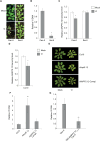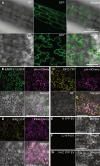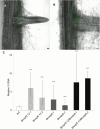Nitrate transporter protein NPF5.12 and major latex-like protein MLP6 are important defense factors against Verticillium longisporum
- PMID: 38666306
- PMCID: PMC11233413
- DOI: 10.1093/jxb/erae185
Nitrate transporter protein NPF5.12 and major latex-like protein MLP6 are important defense factors against Verticillium longisporum
Abstract
Plant defense responses to the soil-borne fungus Verticillium longisporum causing stem stripe disease on oilseed rape (Brassica napus) are poorly understood. In this study, a population of recombinant inbred lines (RILs) using the Arabidopsis accessions Sei-0 and Can-0 was established. Composite interval mapping, transcriptome data, and T-DNA mutant screening identified the NITRATE/PEPTIDE TRANSPORTER FAMILY 5.12 (AtNPF5.12) gene as being associated with disease susceptibility in Can-0. Co-immunoprecipitation revealed interaction between AtNPF5.12 and the MAJOR LATEX PROTEIN family member AtMLP6, and fluorescence microscopy confirmed this interaction in the plasma membrane and endoplasmic reticulum. CRISPR/Cas9 technology was applied to mutate the NPF5.12 and MLP6 genes in B. napus. Elevated fungal growth in the npf5.12 mlp6 double mutant of both oilseed rape and Arabidopsis demonstrated the importance of these genes in defense against V. longisporum. Colonization of this fungus depends also on available nitrates in the host root. Accordingly, the negative effect of nitrate depletion on fungal growth was less pronounced in Atnpf5.12 plants with impaired nitrate transport. In addition, suberin staining revealed involvement of the NPF5.12 and MLP6 genes in suberin barrier formation. Together, these results demonstrate a dependency on multiple plant factors that leads to successful V. longisporum root infection.
Keywords: Brassica napus; Verticillium longisporum; Arabidopsis; MLP6; NPF5.12; major latex protein; nitrate.
© The Author(s) 2024. Published by Oxford University Press on behalf of the Society for Experimental Biology.
Conflict of interest statement
The authors declare that there are no conflicts of interest.
Figures






Similar articles
-
Suppression of abscisic acid biosynthesis at the early infection stage of Verticillium longisporum in oilseed rape (Brassica napus).Mol Plant Pathol. 2019 Dec;20(12):1645-1661. doi: 10.1111/mpp.12867. Epub 2019 Oct 11. Mol Plant Pathol. 2019. PMID: 31603283 Free PMC article.
-
Potential for Seed Transmission of Verticillium longisporum in Oilseed Rape (Brassica napus).Plant Dis. 2019 Aug;103(8):1843-1849. doi: 10.1094/PDIS-11-18-2024-RE. Epub 2019 May 20. Plant Dis. 2019. PMID: 31124750
-
Contrasting Patterns of Colonization with Verticillium longisporum in Winter- and Spring-Type Oilseed Rape (Brassica napus) in the Field and Greenhouse and the Role of Soil Temperature.Plant Dis. 2019 Aug;103(8):2090-2099. doi: 10.1094/PDIS-01-19-0236-RE. Epub 2019 Jun 18. Plant Dis. 2019. PMID: 31210597
-
The Vascular Pathogen Verticillium longisporum Does Not Affect Water Relations and Plant Responses to Drought Stress of Its Host, Brassica napus.Phytopathology. 2017 Apr;107(4):444-454. doi: 10.1094/PHYTO-07-16-0280-R. Epub 2017 Feb 15. Phytopathology. 2017. PMID: 27992306
-
Verticillium longisporum, the invisible threat to oilseed rape and other brassicaceous plant hosts.Mol Plant Pathol. 2016 Sep;17(7):1004-16. doi: 10.1111/mpp.12350. Epub 2016 Apr 4. Mol Plant Pathol. 2016. PMID: 26663851 Free PMC article. Review.
Cited by
-
Transcriptomic Analysis Reveals Candidate Hub Genes and Putative Pathways in Arabidopsis thaliana Roots Responding to Verticillium longisporum Infection.Curr Issues Mol Biol. 2025 Jul 10;47(7):536. doi: 10.3390/cimb47070536. Curr Issues Mol Biol. 2025. PMID: 40729005 Free PMC article.
-
Identification and analysis of major latex protein (MLP) family genes in Rosa chinensis responsive to Botrytis cinerea infection by RNA-seq approaches.Front Plant Sci. 2024 Dec 13;15:1511597. doi: 10.3389/fpls.2024.1511597. eCollection 2024. Front Plant Sci. 2024. PMID: 39735770 Free PMC article.
References
-
- Alonso JM, Stepanova AN, Leisse TJ, et al.. 2003. Genome-wide insertional mutagenesis of Arabidopsis thaliana. Science 301, 653–657. - PubMed
-
- Barberon M, Vermeer J, De Bellis D, et al.. 2016. Adaptation of root function by nutrient-induced plasticity of endodermal differentiation. Cell 164, 447–459. - PubMed
-
- Benjamini Y, Hochberg Y.. 1995. Controlling the false discovery rate: a practical and powerful approach to multiple testing. Journal of the Royal Statistical Society. Series B 57, 289–300.
MeSH terms
Substances
Grants and funding
LinkOut - more resources
Full Text Sources
Molecular Biology Databases

